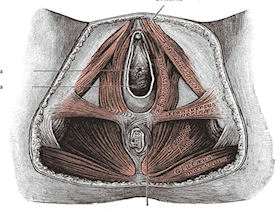Objective
The PFIQ-7 is a shortened version of the PFIQ and is used to assess life impact in women with pelvic floor disorders. It includes all of the Incontinence Impact Questionnaire-7 as well as items related to other pelvic floor disorders.[1]
Intended Population
Women with disorders of the pelvic floor including urinary incontinence, pelvic organ prolapse, and fecal incontinence.[1]
Method of Use
The PFIQ-7 consists of 3 scales of 7 questions each taken from the Urinary Impact Questionnaire, the Pelvic Organ Prolapse Impact Questionnaire, and the Colorectal-Anal Impact Questionnaire. The 3 scales are scored from 0 (least impact) to 100 (greatest impact) and an overall summary score (0 to 300).[1]
Evidence
Reliability
Each of the 3 scales (Urinary Impact Questionnaire, Pelvic Organ Prolapse Impact Questionnaire, and Colorectal-Anal Impact Questionnaire) correlates highly with their long forms (r = .96, r – .96, r = .94, respectively, P[1]
Validity
The PFIQ-7 demonstrates construct validity as it demonstrates a significant association with appropriate measures of symptom severity and pelvic floor diagnoses.[1]
Responsiveness
The PFIQ-7 demonstrated moderate responsiveness with an effect size of .67 and a standardized response mean of .63. The ability of the PFIQ-7 to discriminate between subjects who indicated that they were “worse” after surgery from those who indicated they were “better” was excellent with c-statistic of .88[1]
Miscellaneous
The PFIQ-7 demonstrated a statistically significant improvement at 3 to 6 months after surgery, but the responsiveness was somewhat less than the PFDI-20.
One of the strengths of the PFIQ-7 is that it give a comprehensive assessment of the effect of pelvic floor disorders on the quality of life of women, rather than only assessing one aspect of pelvic floor function such as urinary incontinence. Its relative length makes it easy to use in both clinical and research settings.
Further studies are needed to determine the between-treatment MCID (clinically meaningful change in quality of life[2]) and the MCID of the individual scales.[1]
Links
Pelvic Floor Impact Questionnaire (PFIQ-7) on the Rehabilitation Measures Database
Paper by Barber et al 2005 describing the development of the PFIQ-7
Read 4 Credit
References
- ↑ 1.01.11.21.31.41.51.6 Barber MD, Walters MD, Bump RC. Short forms of two condition-specific quality-of-life questionnaires for women with pelvic floor disorders (PFDI-20 and PFIQ-7). Am J Obstet Gynecol 2005;193:103-113.
- ↑ Crosby RD, Kolotkin RL, Rhys Williams G. Defining clinicallyfckLRmeaningful change in health-related quality of life. J ClinfckLREpidemiol 2003;56:395-407


